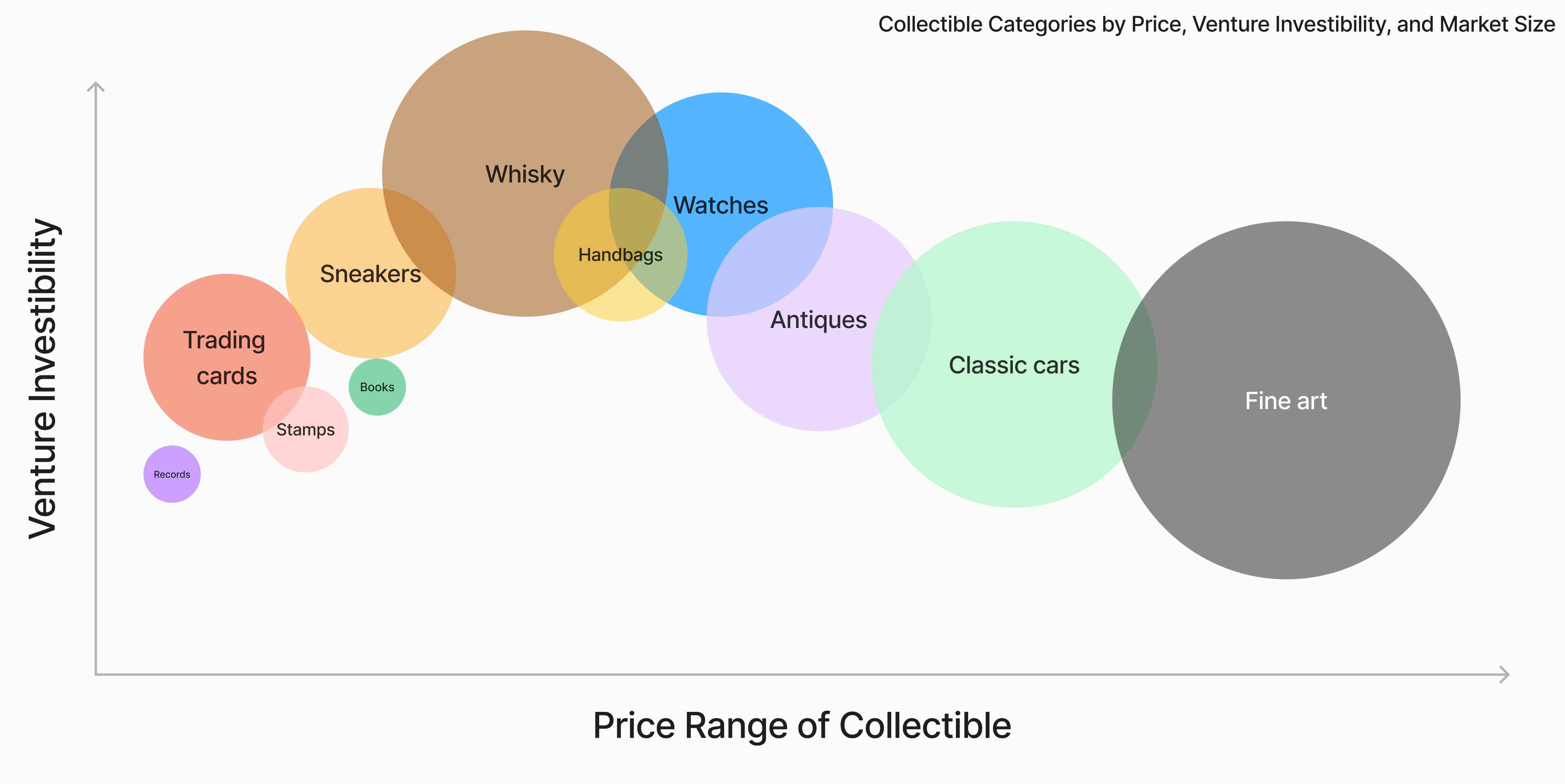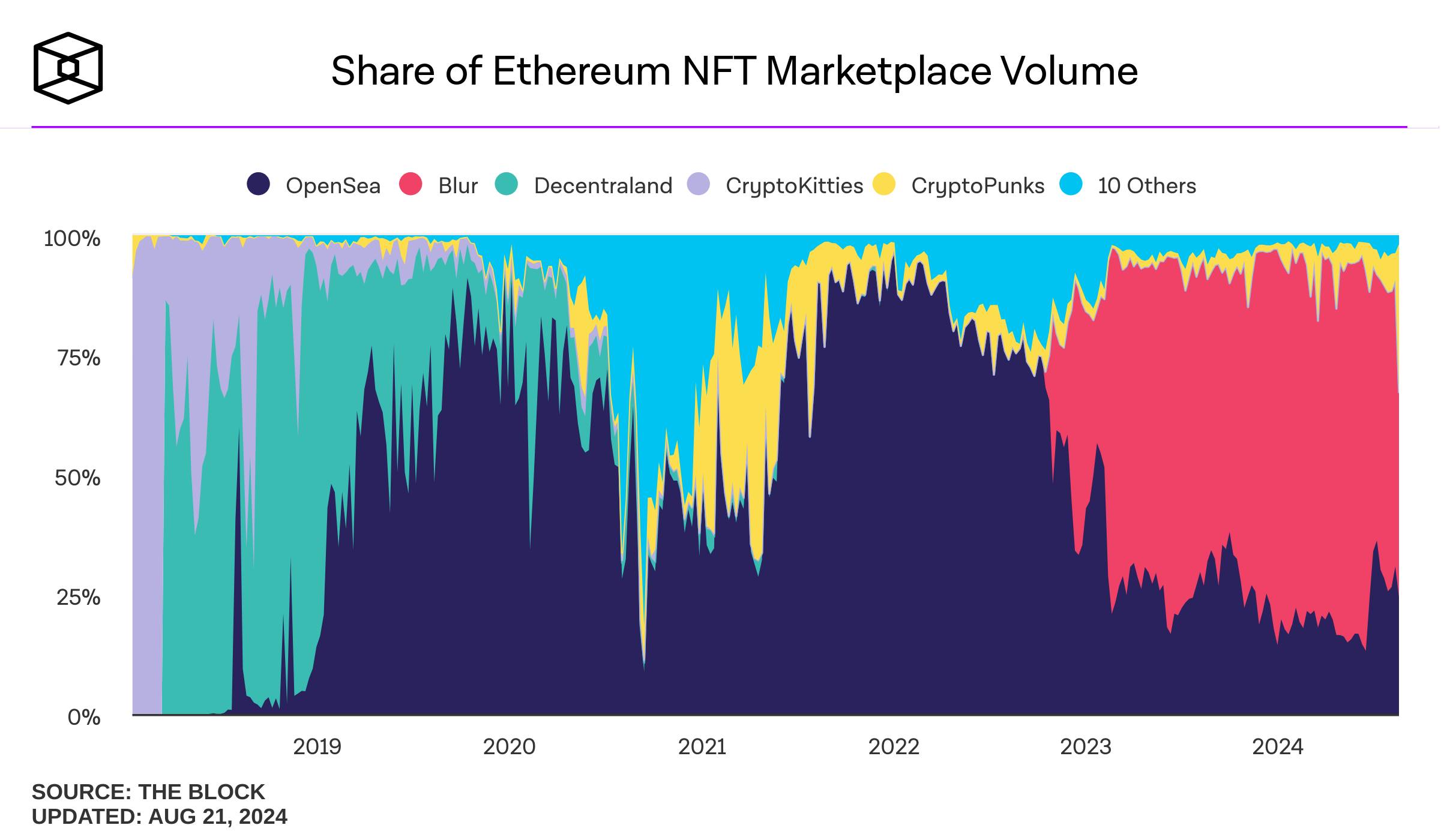Based on brand-based BECMs are more attractive to venture capital than time-based BECMs.
Author: Vishal Kankani & Eli Qian
Translation: DeepTechFlow
The collectibles market is booming. Today, more than a third of Americans consider themselves collectors, and by 2024, the size of the collectibles market will reach nearly 500 billion US dollars. The collectibles industry is thriving, and blockchain is making inroads into this field.
More and more collectors are actually traders, with the sole purpose of buying and selling collectibles worth billions of dollars—ranging from rare whiskies to luxury watches and handbags—for profit. Although online markets have evolved from classified ads to all stores and then to vertical markets, they have not yet developed to serve these traders in the most efficient way.
To make flipping transactions as efficient as possible, the collectibles market needs to have 1) instant settlement, 2) physical custody, and 3) authentication. Currently, leading collectibles markets such as Bring a Trailer, StockX, and Chrono24 do not provide these three elements. Cash settlement is not a feasible option; instead, physical settlement is the default choice, with settlement times usually calculated in days or weeks. For larger collectibles, such as cars, physical storage quickly becomes an issue (where do you put 20 cars for flipping?). For smaller collectibles, trading is often done through vertical markets like Facebook groups, where fraud is a persistent challenge. All of these factors make trading collectibles highly inefficient in today's market.
We see a huge opportunity to create a new market design specifically for collectible traders, called "Blockchain-Enabled Collectibles Markets" (BECMs). These markets provide instant transactions through cash settlement, reducing settlement times from weeks to seconds, using stablecoins, and utilizing NFTs as digital representations of physical assets held by trusted custodians or authenticators.
BECMs have the potential to reshape the multibillion-dollar collectibles market, as they make the following possible: 1) unifying the market and increasing liquidity (compared to the current fragmented black market), 2) eliminating the need for personal physical storage, thereby encouraging more trading, 3) increasing trust by providing authentication, and 4) financializing collectible behavior by facilitating lending, which was previously impossible. We believe that the results of these efficiencies will greatly expand the total addressable market (TAM) of the entire collectibles market, as more traders, liquidity, inventory, and markets come online.
However, while it is technically possible to build a BECM for any collectible category, not all BECMs will be equal. The rest of this article will focus on the characteristics that make BECMs investment-worthy. We will break down seven key features along three design axes: the financial axis, the real-world axis, and the emotional axis.
Financial Axis
Lack of vertical trading venues
Currently, most collectibles do not have dedicated markets or exchanges to centralize liquidity and facilitate public price discovery; instead, they trade on many different platforms—WhatsApp chats, Facebook groups, auction houses, etc.—which disperses liquidity. This means there is a great opportunity to serve underserved collectibles markets; however, if existing market structures are already efficient, BECMs will find it difficult to compete. These markets are not very attractive to venture capitalists.
Based on our initial assessment of the collectibles market, the markets for wine and spirits, handbags, and watches have the greatest potential for improvement. These collectibles are mainly traded on the black market, lacking liquidity and price discovery, putting the existing markets in a state of disruption.
Appropriate price points
For a collectible category to be investment-worthy, the prices of its collectibles should be affordable enough for collectors to fully own the asset. Partial ownership of an asset is acceptable for financial investments, but as a collector, having half ownership of a luxury handbag goes against the purpose of collecting. Additionally, excessively expensive collectibles reduce the overall buyer pool, reducing the liquidity of these collectible categories. For example, no one would flip a million-dollar Ferrari because there is no 24/7 demand overlap.
On the other hand, the prices of collectibles need to be high enough to provide social status, a sense of exclusivity, and emotional satisfaction. If something is too cheap, anyone can own it, which will not attract emotionally and status-driven buyers, thereby reducing market liquidity. Additionally, price points should be high enough to make potential market makers willing to spend time researching the collectible category. If items are too cheap, they must be traded more frequently to make the unit economics reasonable. However, cheap collectibles cannot provide enough social status to attract collectors and form a liquid market.
We believe that the ideal price range for investment-worthy BECMs is roughly between $1,000 and $100,000. This makes collectibles such as sneakers, watches, handbags, and antiques ideal candidates for BECMs. Collectibles such as art and cars are too expensive for most people, and collectibles such as records and stamps may not be suitable for BECM due to their lower prices.

Image: The investability of venture capital is our subjective assessment, and the size of the bubbles corresponds to the market size, with sources including vinyl records, trading cards, stamps, rare books, sneakers, whisky, handbags, watches, antiques, art, and classic cars.
Considered as a store of value
Collectors are buyers seeking status. They are referred to as "HODLers." Their presence is crucial to maintaining a healthy price floor in the collectibles market. This indicates that a collectible is not a passing fad, but rather signifies its enduring cultural relevance. This is because for an item to be considered a store of value, it must be believed by enough people to have enduring cultural relevance for a long time into the future. Collectibles considered as a store of value are attractive across different generations and are often resistant to technological changes.
Art is a prime example. Humans have enjoyed art for thousands of years, and it is reasonable to assume that people will continue to appreciate art for thousands of years into the future. Vinyl records, on the other hand, present a more complex case. They have broad appeal among older generations, but whether the generation that grew up in the post-iPod era will continue to value vinyl records remains to be seen.
Real-world Axis
Storage challenges
Collectibles that occupy significant physical space or are prone to degradation are prime candidates for BECMs, representing good investment categories. It is difficult for the average person to store fragile collectibles such as wine and art for long periods without taking environmental precautions (humidity, temperature, light, etc.). Even if you could magically solve these issues, you would quickly encounter space limitations—storing over 50 paintings or 100 bottles of wine in most homes is impractical. Even if you could magically eliminate space limitations, you would still face insurance issues.
If storage for a particular collectible category is trivial, establishing a BECM may still be profitable, but the barriers to entry will be much lower, leading to increased competition, dispersed liquidity, and diminished pricing power. NFTs are the best example in this category: they are not affected by the environment, do not occupy any physical space, and the transparent origin on the blockchain makes fraud nearly impossible, making it difficult to establish a defensible NFT market.

Image: Ethereum NFT marketplace trading volume, source: The Block
We believe that wine, whisky, and cars face the greatest storage challenges in terms of collectibles, and therefore, the interests of these collectors will benefit the most from BECMs. Wine and whisky are extremely sensitive to the environment, requiring special insurance vaults that control temperature, humidity, light, and other factors (our investment in Baxus is addressing this issue). Cars require large garages—most people struggle to store more than 3 or 4 cars at home. Trading cards, sneakers, watches, and handbags are relatively easy to store—these collectors can still benefit from outsourced storage, but the marginal improvement is smaller.
Trust issues exist
In addition to addressing physical custody issues, BECMs must also address authenticity issues to attract investors.
Today, collectors face serious trust issues; buyers and sellers in group chats rely on community recommendations and anonymous moderators to vet their counterparts. Fraud is commonplace in almost every collectible, making it difficult for market participants to maintain 100% confidence in their purchases. Establishing market standards and trusted authenticators is crucial for attracting collectors, alternative asset investors, and speculators to market liquidity.
There are two ways of authentication:
1. In-house authentication: This requires domain expertise and is more complex in operation. If the market misidentifies items, it will need to compensate collectors. However, this can be a good moat, especially when items are difficult to authenticate. Markets conducting in-house authentication need to manage potential conflicts of interest and require some oversight to maintain buyer trust.
2. Outsourced authentication: This is simpler but will reduce the market's potential profits. Therefore, when a collectible category is easier to authenticate, outsourcing is more reasonable. Another benefit is that outsourced authentication naturally provides separation between the market and authenticators, mitigating potential conflicts of interest.
If a BECM can establish trust and provide a refund guarantee, it can build a competitive moat, making it attractive to venture capital. Items such as watches, handbags, and wine are rife with counterfeits. BECMs have a good opportunity to increase trust and attract new collectors who are reluctant to collect due to fraud concerns.
Emotional Axis
Source of time and brand
In the context of collectibles, the source is how an item gains its value. For collectibles, it is often based on time or brand.
Based on time-based sourcing, it means that assets appreciate due to their age and historical background. Rare books are an example of this category. Assets with time-based sourcing typically only trade in the secondary market—there is no central issuer, and the assets are usually unique or few in number. This characteristic may limit activity in the secondary market, as collectors do not need ongoing funds to purchase new issuances, and HODLers suppress the available trading supply. Constitution DAO is a good example—they have yet to return the copy of the constitution they bid on to the secondary market. Other collectibles with time-based sourcing include antiques, art, cars, and firearms.
On the other hand, brand-based sourcing refers to the reputation a brand has built over time, as the market begins to perceive its products as valuable. Watches are a typical example of brand-based sourcing. Top luxury watchmakers—Rolex, Patek Philippe, Richard Mille, and Audemars Piguet—control nearly half of the luxury watch market based on brand value. Brand-based collectibles have a central, profit-seeking issuer that continuously releases new items. Unlike time-based sourcing collectibles, these encourage secondary market activity, as collectors need funds to purchase new supply and turn to the secondary market for sales.
Therefore, brand-based BECMs are more attractive for venture capital than time-based BECMs.
Enthusiastic Collector Base
Venture capitalists want to see strong emotional attachment to a collectible; this is a precursor to having HODLers. Without them, achieving organic liquidity is difficult. Therefore, a BECM with a weak community will struggle to attract trading volume and lose investment appeal.
The best signal of a thriving community is the level of passion to the point of contention. We want to see car collectors debating the best supercar ever made, or handbag enthusiasts advocating for the most underrated brand. An enthusiastic collector base will be active in various corners of the internet—subreddits, forums, and group chats.
The Cambrian Era of Collecting
The future is not limited to BECMs for watches, handbags, and wine. There are hundreds of other investable categories.
The opportunity for BECMs lies in opening up new markets for various collectibles and improving access to new alternative investments.
We have long been interested in how crypto touches the real world, having made an initial investment in Helium back in 2019, which pioneered the concept now known as DePIN. We have learned a lot from early participation in DePIN and shared some thoughts on the market opportunities for DePIN here.
免责声明:本文章仅代表作者个人观点,不代表本平台的立场和观点。本文章仅供信息分享,不构成对任何人的任何投资建议。用户与作者之间的任何争议,与本平台无关。如网页中刊载的文章或图片涉及侵权,请提供相关的权利证明和身份证明发送邮件到support@aicoin.com,本平台相关工作人员将会进行核查。




